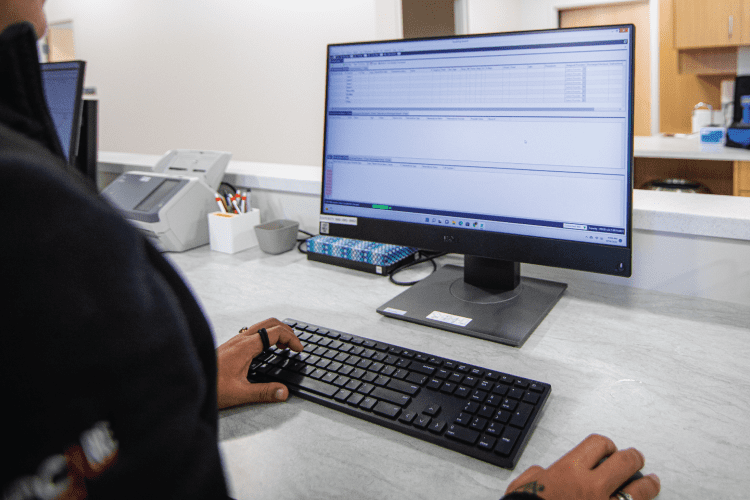
Staffing has been a major pain point for urgent care over the last few years. The early days of COVID-19 took a lot of staff out of the game — for a variety of reasons. Which led to a desperate struggle to find qualified humans to fill open roles. Now that volume is normalizing, clinics are overstaffed (which means you’re not getting the business needed to support your labor schedule), and also staff are demanding higher wages. Since labor — specifically provider labor — is the highest cost of an urgent care business, clinic owners may feel like they’re bleeding money.
This guide outlines tips from Experity consultants and other internal experts who routinely help customers solve these kinds of problems. You’ll learn how to approach lean staffing, where to improve training for more revenue, and how to spend less on labor using your technology.
Chapter One
One thing that a lot of clinics did during the peak of COVID was to open new locations to serve patients with lower acuity (i.e., COVID19 testing). As the pandemic transitioned to endemic, these clinics are not only getting fewer patients for COVID testing and vaccinating (which is what they were built to do,) but they also have a difficult time competing with nearby urgent cares that can accommodate a wider range of patient needs.
When these customers reach out to Experity about lost revenue, Alan Ayers, President of the National Occupational Medicine Network, says the first question he asks is what their staffing model looks like. Often times these clinics have more staff member vehicles in the parking lot than they do patients. This is a pretty good indicator of a bloated staffing model.
Ayers says that the metric driving wait times should be used for staffing: patients per hour per provider (P/H/P). Clinics vary in what they need this to equal to either break even or profit, so calculate that ideal number for yourself if you don’t know it. Then use the reporting in your PM (or better yet, business intelligence solution if you have it) to calculate this — not only for your current situation, but also to get insights into historical numbers. Early indicators suggest that the 2022-23 flu season could mirror pre-pandemic numbers or higher, so these historical metrics may be more relevant than they were over the last couple of years. When you can predict seasonal volume, you can better plan your roster.

Chapter Two
Having your P/H/P and a data-informed idea of volume, you want to right-size your staff for the expected number of patients. For some clinics, this calls for cross-training to cover all the duties. For example, a smaller clinic may have times when it makes sense to only have one front desk person and one physician or other provider on duty. That front desk person may have to take on additional non-medical tasks, and that provider may have to cover duties that an MA, NP, or PA would do when you’re fully staffed. Some clinics even have providers help at front desk as needed.
When you’re thinking about the staff that you absolutely need to schedule, ask yourself what tasks they perform and whether these tasks add value. Every staff person should only be engaged in value-added tasks.
For example, if the MA asks patients a bunch of questions, and then the provider comes in and asks the same questions, this is a waste of everyone’s time. Similarly, printing out and dealing with paper when information is accessible through your EMR, or a staff member dropping everything to wait for a print-out takes up time that doesn’t need to be spent.
Cross-training MAs or RTs to handle front desk duties when needed, or having providers take vitals might be the best way to cover your bases with a reduced staff. Lean staffing in this way can be difficult for larger systems to implement because the gravitas of higher-ed positions. An approach that may help in this case is to frame up duties based on goals.
For instance, each staff member should have their own metrics, but some goals are shared, like door-to-door time. If everyone is motivated to meet these goals — through performance reviews, bonuses, or other rewards — it can shift thinking from “not my job” to “what can I do to contribute?”
Your company culture also plays into the success of cross-training. We have a free webinar on-demand, The Top Behaviors of a Winning Urgent Care Team, that can help you understand this better.
In some cases, you can also train up. You may be able to have a physician’s assistant or nurse practitioner cover some provider duties. But there is a caveat: plans that require full credentialing don’t have an option for temporary credentialing, so you need to be careful about who is doing what.
In that vein, know that sometimes locum tenens should stay locum tenens. You don’t want to credential them if they only work once a month — once credentialed, they’re part of your practice, and you cannot bill them as a locum.
The right lean staffing model for you depends on your circumstances, so remember: all tasks should add value, and your metric is patients per hour per provider.

Chapter Three
Part of being able to afford your staff is to get paid in full for each visit. If anything goes wrong on the administrative side, you’re dealing with unnecessary denials and rejections that hurt your revenue. There are a couple of things you should investigate today to improve this.
The first is for those clinics that have multiple lines of service like OccMed. We find it’s very common that staff is improperly trained on these additional service lines. That means their data entry may be incorrect, or if a patient comes in saying they got hurt at work — staff thinks they’re billing an employer without checking that the employer is actually a client. Both scenarios lead to not getting paid. And it could be happening at an alarming frequency.
The second problem is something we see with most clinics, which is in the general billing process. Missteps often go unnoticed because no one has the time or insight to run reports that flag issues. And when it’s evident there is a problem, managers will look at the back end of the billing process, which does not solve the larger issue.
If there is a problem on the back end of billing, the first place you should look is the front end. This is where most mistakes occur, whether due to inconsistent processes, improper training, or inefficiencies that rush people into missing things.
If you’re unsure how to diagnose billing issues, a few ways to flush these out are:

Chapter Four
Once you’ve identified your issues, your long-term solution should include solid standard operating procedures. Create these — and train on them and hold people to them — on processes for data capture in all scenarios, as well as checklists and other best practices to ensure that billing is done accurately the first time.
It also helps to lay out who is responsible for what, especially if you’re expecting higher-paid employees to pitch in on tasks that weren’t previously part of their job. Identify what screens triage staff are responsible for filling out in the EMR. Clarify things like whether the nurse will do vitals, the provider document chief complaints, and the medical assistant enter the lab results, Remember, to attest for Meaningful Use, a provider is required to fill out certain EMR sections versus a nurse or medical assistant.
Understand more about SOPs for strong revenue cycle management in this blog.
Chapter Five
Here we circle back to the theme of value-added responsibilities. So often staff takes on tasks that could be automated — either through integrations within the tech stack or even having patients complete some of the work. In the latter case, you are actually having patients do work for you, often better/more accurately than staff, and they’re doing it for free.
Think of any automated system we’re all familiar with: self-checkout at grocery and retail stores, self-check-in at hotels, kiosks and devices to place food orders — some restaurants even still provide service to take an order but have customers self-pay right at the table. We’re all used to doing these things for ourselves, and much of the time, it makes things faster for everyone. Patients want to get through faster, too. You can eliminate a lot of time-consuming steps by handing off manual data entry to patients with technology.
Your tech should also eliminate other non-value-add tasks like duplicative entries, payment reminders, and any other process that do not need to be repeated every visit (e.g., asking for a credit card.) Technology doesn’t just improve speed and accuracy; it truly acts as an employee who takes care of time-consuming, monotonous tasks so the rest of your staff can focus on what matters most.
Here are just a few examples of how your technology can ease staff responsibilities:

Chapter Six
EMR/PMs are complex, so it’s easy to forget or simply not know all the ways it can help you be more efficient. Before you invest in new technology, you should make sure you’re optimally leveraging the tools you already have. Reach out to your vendor for help with training or other advice they can provide for your specific challenges. You pay a lot of money for these tools — your vendor should act as a partner to help you use them to their fullest capacity.
If you don’t have this kind of relationship with your vendor and you want one, partnership is at the core of Experity. Take a look at our resources and watch our video. You can also sign up for a demo to see if we can help you get your business to the next level. Start here.